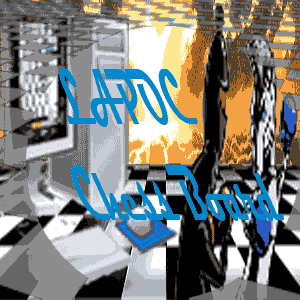| Back to Back Issues Page |
 |
|
LCB, Issue #004 -- Nailing Down Basic Mates and Opposition September 01, 2011 |
Basic Checkmates and OppositionLapoc Chess Board, Issue #004 -- Nailing Down Basic Mates and Opposition learn and play online chess Hi there. Time to resume our journey to endgame mastery. Last time we talked about the staircase technique and the shrinking box technique. They are ideas that form the basis of our thinking in the endgame. We'll be developing these same thought processes and adding some more nuggets to the mix this month. We'll be looking at some basic mating procedures, a little trickier than last month but not much. These ones are a queen versus a minor piece and we'll be doing two of them. In one we will discuss an endgame with a King and Queen up against a King and Bishop. In the second we will talk about a King and Queen taking on a King and Knight. They are both won games for the side with the queen and you will learn how she always comes out on top. We need to talk about the star of the show in the endgame and pretty much the entire game. This is the when the king becomes the central player. Finally we'll wrap up on why opposition is the holy grail in the endgame. What Pieces are Enough to Win?What material wins and what does not? Along with your own king: A queen mates. Two rooks mate. A rook mates. Two bishops mate. A bishop does not mate. A bishop and knight mate. Two knights do not mate. A knight does not mate. Two connected pawns can sometimes mate but one pawn does not. Pawns do not generally try to mate the enemy king although you should take the chance if it comes. But generally endgames with pawns, which are the vast majority of endgames, revolve around trying to promote pawns to queens. K&Q vs K&BLet's start with king and queen against king and bishop. To the uninitiated it may seem as if yes the queen has an advantage but the bishop can put up a fight. Sadly for bishop fans this is not the case. The bishop offers practically no resistance whatsoever. If you have the side with the queen don't make the mistake of even trying to capture the bishop. Ignore it instead! Remember always that the bishop only has access to half of the board and is stuck on either light squares or dark squares. All you have to do is keep your king and queen on the opposite color squares from the bishop as much as possible. If your opponent's bishop is moving on the dark squares then your king and queen operate on the light squares and vice versa. You just complete the simple shrinking box technique to checkmate the opposing king. You can pretend the bishop doesn't exist. It's attempts to impede you will be futile. If anything it's presence is good for you because now you don't have to worry about stalemate. Not that you would make that mistake right!? K&Q vs K&NWhen a queen comes up against a knight, the king and knight will try to stay close together and fight their way to the edge of the board. The secret is for king and queen to work together to force king and knight to edge of the board. There they can be prized apart because their scope is restricted. The weaker king will have to abandon his knight to avoid checkmate. After the knight is gone, it's pretty easy after that. The only thing to watch out for is a royal fork which means an instant draw. The Fighting KingA lot of people think that the king is a weak piece. It's easy to form this conclusion. After all you spend the entire game wrapping the king up in cotton wool while others march forward to lock horns with the enemy. But just because you feel like you have to baby sit your king in the first 25 or 30 moves doesn't mean he can't fight. It just means he needs to lay low until the big guns are out of the way. In the final stages the two kings race out towards the center. They become central players in the struggle for victory. Your king is a fighter! A real endgame bruiser, slightly stronger than a minor piece. A king does not have a points rating like the others as you need him to stay alive but he has a fighting value of four. He does not have the range of a bishop but can reach every square and that is why he's stronger. OppositionOne of the main endgame objectives is to achieve direct opposition. This is where the two kings are directly facing each other on any rank or file with only one square between them. The one that must move is the one in retreat, on the run. The other is now in command. He will chase after his rival, pushing him back, eating into his position. There are dire consequences for the king on the back foot. The dominant king can break into his camp and start gobbling up pawns. To gain full appreciation of everything mentioned here read the notes as you play through the moves.
P.S. Play through the basic checkmates and opposition. Comments, ideas, feedback? I'd be stoked to hear from you. Get in touch See you next month. Ken 
|
| Back to Back Issues Page |